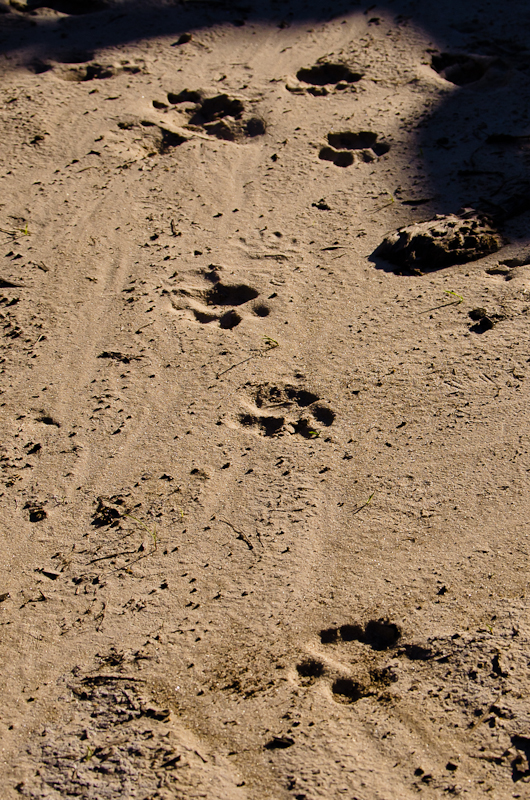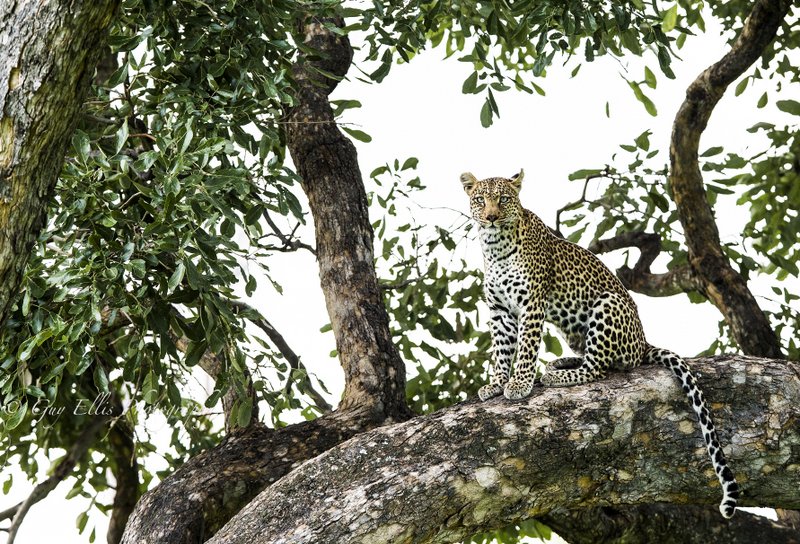|
Soon after we departed on our second afternoon safari last weekend, we picked up fresh female leopard tracks in the dusty road. Brakes were applied and Custard, our guide, and the Leopard ID Project team set to work interpreting the pristine spoor. It was quickly ascertained that the leopardess had walked here within the last few hours and the hunt was on. Perhaps because of the dense bush on either side of the road, we were dealt a break by our feline target as the tracks remained in the road for kilometer after kilometer, only deviating for small periods to negotiate the lingering puddles from the previous week’s rain. Each time we lost the tracks, we dismounted and conducted a thorough search of the area until we found where she rejoined the road. The tracks were fresh no doubt: no insect or bird tracks were atop of the prints and the wind had not yet caused them to lose their ‘shine’. As we rounded each corner, we all craned our necks as one, hoping to find our elusive goal striding confidently down the road; but alas, corner after corner yielded nothing more than more tracks. After an hour of intense tracking we reached an area of the road that was completely under water. It was obvious that the leopard would have rounded the obstruction and there was no way we would be able to follow her amongst the vegetation where she is most comfortable. We left the comfort of the vehicle once more to try and establish at least a final direction so that we could loop round and hope that she emerged from the tangled undergrowth on to another road. As we stared in vain at the hard ground that had been baked by the sun, Custard’s keen eyes picked out a silhouette in the towering trees before us. As we followed his enthusiastic pointing, the unmistakable shape of a lounging leopard met our eyes about 75 meters off the road. We quickly and quietly returned to the vehicle and started to pick a careful path closer to the leopard. In order not to scare her, we approached slowly, stopping every 10 meters of so to snap a few pictures in case she dismounted and melted into the dense undergrowth. The enigma resolved as we closed the gap and we were delighted to see that this was the same leopard that had graced us with our closest encounter during our trip in October last year. Her unmistakable eyes watched us coolly as we approached. 4 months ago I was no more than 30 centimeters from those eyes as the same female boldly strode towards the vehicle and examined its occupants and I will never forget them. Her eyes were like ice. A pale blue colour like the clear waters of the ice worlds, her eyes looked as though they should be cold and lifeless, but somehow, thanks to the infinite wonder of nature, those eyes did not instill fear, just wonder. She raised herself to a seated position on the tree limb and regarded us with interest. A yawn and a stretch followed before she casually strode along the branch and began a controlled and elegant dismount. We followed from distance so as not to disturb her progress and marveled at the way that her pelt, perfectly designed through millennia of evolution, allowed her to appear and disappear right before her eyes. Her relaxed nature was evident as from time to time our paths would cross and she would casually walk past the front of the car as if we did not exist. Nothing needed to be said as this perfect organism graced us with her presence and although she disappeared as quickly as we had found her, we were not despondent. Tracking and finding your own leopard is far more satisfying than responding to a radio and her melting into the bush in front of us without trace simply accentuated the experience of spending time, albeit brief, with this animal that is designed to be a master of camouflage. After all, without this skill, her survival would be in jeopardy. We returned to camp full of excitement after a great sighting and for the Leopard ID Project representatives, it was great to touch base with the same animal that had closed the curtain so spectacularly on our last trip. New photos have allowed us to augment our database and we look forward to helping to preserve this beautiful cat’s existence with more trips to the area in the future.
1 Comment
Machaba Magic The delightful Machaba Camp, on the fringes of the Okavango Delta, was once again the destination for our latest Leopard ID Project safari, hosted by Completely Unique Safaris (www.CompletelyUniquesafaris.com). After our last trip had yielded 10 different individuals and over 20 separate leopard sightings, we had high expectations of course, but being summer in the Delta, we also knew that the chances of finding anything in the dense vegetation would be tough! Despite our cautious approach, we landed on the airstrip full of excitement and anticipation as we took in the wetland wonderland that is the mighty Delta. Grass as tall as us and densely foliated trees dominated the landscape, and puddles populated by a large variety of water-birds littered the roads. Despite the instant revelation that spotting Africa’s most elusive big cat would be a mammoth task, we took a deep breath and admired the lush surroundings. The Okavango Delta is truly worthy of its recent inclusion as one of the natural wonders of Africa and to be privileged to stand within it is an honour in itself. We set off for the lodge enraptured by the myriad shades of green that painted the landscape, but before we had time to settle into our seats, we were met by a welcoming party of the canine persuasion! A pack of wild dogs lounged in the shade of tree and, seemingly aware of our excitement, took it upon themselves to frolic playfully in front of us before trotting off to a puddle to engage in some great games of which only they know the rules! Only in the Delta!? A good start for sure but we were back to look for leopards…. The Machaba concession had one more surprise in store for us before we arrived at the lodge however. A massive apple leaf tree towered above the surrounding vegetation as we drove across what could only be described as a pasture, but something looked out of place amongst the branches. A familiar shape lolled across a horizontal branch 5 meters above the ground enjoying the relief from the harsh Botswana sun. The Machaba female had come to greet us on our return! A stalwart of the area at about 10 years old, her genetics are rife in the area; a testament to her brilliance as a mother in an area of such high leopard density. Our trip to October revealed various sightings of the camp’s namesake and her young cub and it was as though we never left. Stowed safely beside her, a half-eaten impala carcass swung gently in the breeze as if it hung in a butcher’s shop window. She was satiated for now but we sat in silence and took in the scene, her mottled coat the perfect camouflage to blend with the dappled light filtering through the leaves. Our guide, Custard, told us that she,her now 1 year old male cub, and a male cub from her previous litter had been found feasting on the kill that morning. Although there was no sign of the youngsters, we had high hopes of catching up with both of them that evening! Blog and Photos by Ben Coley
|
Authors:Leopard statuses and happenings by Leopard ID Project team leaders. Archives
October 2014
Categories |










 RSS Feed
RSS Feed
